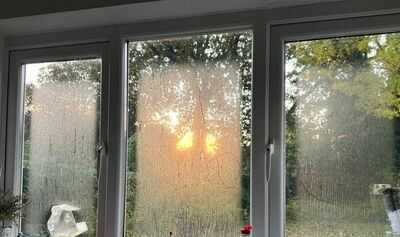
Condensation remains the nemesis of every homeowner during winter months. You wake up, pull back your curtains, and discover yourself confronted by a sheet of water droplets blanketing your window.
It might seem appealing to ignore this moisture, particularly during a hectic morning, but you should invariably wipe it away - as condensation can trigger mould development. Wiping down your windows each morning can prove tiresome, but it's preferable to prevent condensation from accumulating in the first place.
Numerous tricks exist that claim to eliminate condensation swiftly, and one woman on Instagram tested three methods to determine which one proved most effective.
Ash O'Buachalla posted a video explaining she experimented with three approaches for removing condensation, with one emerging as the "clear winner". Her victorious method requires just one household item - costing as little as 57p.
She explained: "I searched for hacks to fix this problem. I tried three different hacks over four days, and the winner was washing up liquid on a clean and dry microfibre cloth. Wipe it on the entire pane and frames. Wipe it a few times so there's no film left on the windows, and it worked absolutely brilliantly."
Ash maintained that the technique prevented condensation on her windows for approximately two weeks, meaning the method requires regular reapplication, though it certainly surpasses having to squeegee moisture from your windows every morning.
Most households will already have washing up liquid for cleaning dishes, though it can be purchased from supermarkets for as little as 57p if an additional bottle is required.
In her post's caption, Ash disclosed that she had also tested two methods involving placing a bowl on your windowsill. One approach used salt in the bowl, which Ash discovered was merely "20% effective". The alternative involved filling the bowl with sodium bicarbonate, which she claimed was 80% effective.
Both techniques are intended to extract moisture from the atmosphere before it adheres to your windows, whilst the washing up liquid method is designed to prevent moisture from clinging to the surface.
Households should be cautioned before attempting the washing up liquid technique, however, that the moisture will remain in the atmosphere and may settle on other surfaces such as your walls. This can subsequently still trigger mould development, as you haven't addressed the root cause of the issue.
It may prove advantageous to employ the washing up liquid method alongside the salt or sodium bicarbonate solution, or to utilise a dehumidifier to remove moisture from the atmosphere.
How to get rid of condensation1. Increase ventilation
- Open windows regularly, especially after cooking, showering, or drying clothes indoors.
- Use extractor fans in kitchens and bathrooms.
- Consider installing trickle vents on windows or using a dehumidifier.
2. Reduce moisture production
- Cover pots and pans when cooking.
- Dry clothes outside if possible, or use a vented tumble dryer.
- Avoid using portable gas heaters, as they produce excessive moisture.
3. Improve insulation
- Insulate walls, roofs, and windows to keep surfaces warmer and reduce condensation.
- Use double or triple glazing on windows.
4. Maintain consistent heating
- Maintain a steady, moderate temperature in your home rather than letting it become excessively cold.
- Avoid turning the heating off completely in winter.
5. Wipe down surfaces
- Regularly wipe down windows and other affected surfaces to prevent mould growth.
-
Maha govt's football initiative to provide support to rural athletes, Tiger Shroff named as brand ambassador

-
Maha govt extends e-KYC deadline for Ladki Bahin Yojana till Dec

-
Suniel Shetty's Son Ahan Shetty Opens Up On Claims Of Losing Movies Due To High Entourage Costs

-
Popular Ollywood Singer Humane Sagar No More

-
Saudi road accident: RJD leaders express grief over pilgrim deaths
